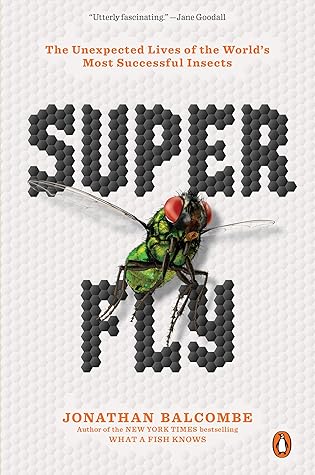Kindle Notes & Highlights
Read between
October 11 - November 10, 2022
“Ogden Nash wrote, ‘God in His wisdom made the fly, and then forgot to tell us why.’
for each one of us, there are actually 17 million flies.
ethology, the study of animal behavior,
African skin maggots,
Half of all clinical cases of disease in the world are transmitted by insects, and flies are the most common carriers.
One in six humans alive today is infected by an insect-borne illness, and more often than not, the footprint left at the crime scene is that of a fly.
Only a tiny proportion, about 1 percent, of the 160,000 known species of flies are harmful to humans.
the beneficial and pretty flower flies (Syrphidae) alone, which are vital pollinators, number over 6,000 described species.
flies belong to by far the most successful collection of animals on Earth: insects.
Insects make up a whopping 80 percent of the approximately 1.5 million animal species so far named, and there are estimated to be between 5 and 10 million species yet to be discovered.
1.4 billion insects for every human.
17 million flies for every human.
the midges, which might turn out to be the most dominant collection of species on Earth.
Some phantom midges amass in such huge numbers in East Africa that locals catch them in swinging buckets, then pack them into balls and cook them into edible masses called kungu cakes.
Today there are about one million known species of insects, of which 350,000 are beetles.
Steve Marshall
Art Borkent
(The novelty rate is the proportion of species found in a sample that are new to science.)
The Canadian Entomologist.
CP Alexander,
Such is the speed with which fruit flies romp through their life cycles that they can complete 25 generations in a year.
Now, casting aside all previous 24 generations, take just the 25th generation of flies emerging from their pupae on December 31 of our hypothetical year. Imagine, then, that these flies are packed into a ball of 1,000 flies per cubic inch. How big do you think the ball is?
a diameter of 96,372,988 miles, stretching from here to the sun with a few million miles to spare.
ubiquitous.
the larvae of the petroleum fly (Helaeomyia petrolei) develop in natural pools of crude oil, where they breathe through a snorkel and feed on the remains of other insects trapped in the goo.
In pre-17th-century Western painting, the presence of a fly on a portrait meant that the subject had died.
According to Groucho Marx, “time flies like an arrow, and fruit flies like a banana.”
Winston Churchill remarked in 1906 to lifelong friend and confidante Violet Bonham Carter: “We are all worms, but I do believe that I am a glow-worm.”
a diversity of interacting species,
a fly’s mouth can act like a syringe (think mosquito), a saw (horsefly), or a sponge (housefly).
There are as many organs in a fly as in a leviathan. —ERNST JÜNGER, THE GLASS BEES
Insects share eight of the ten body systems we have: nervous, respiratory, digestive, circulatory, excretory, muscular, endocrine, and reproductive.
Our two remaining systems—our skeleton and our skin—are replaced in the insect by an exoskeleton made up of rigid plates (sclerites) connected by flexible membranes, which provides effective structural support and protection for a small, mobile organism.
hemolymph (their equivalent of our blood)
Ventilation (or breathing) is handled by a complex, branching set of tubes, the tracheas, which open to the outside of the body at holes called spiracles,
Oxygen is absorbed and carbon dioxide removed by direct diffusion at the tracheoles, crossing the outer membrane and entering or exiting the cells within.
The salivary glands of insects are more versatile than ours; some, for instance, make silk, while others produce compounds that mimic plant growth hormones and stimulate the production of a protective gall—a swelling growth typically occurring on stems or leaves.
In case you’re wondering whether insects fart, they do.
Diptera,
two wings
Flies’ ancestral rear wings have been modified into a pair of club-shaped structures called halteres, which functi...
This highlight has been truncated due to consecutive passage length restrictions.
All other flying insects have four functioning wings, with the exception of beetles, whose front wings have been modified into hardened, protective s...
This highlight has been truncated due to consecutive passage length restrictions.
two main groups o...
This highlight has been truncated due to consecutive passage length restrictions.
suborder Nem...
This highlight has been truncated due to consecutive passage length restrictions.
nematocera translates to “thread-horns”),
identify a nematoceran fly by its slender, frail appearance.
Brachycera include more compact, robust flies wit...
This highlight has been truncated due to consecutive passage length restrictions.


